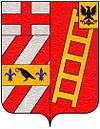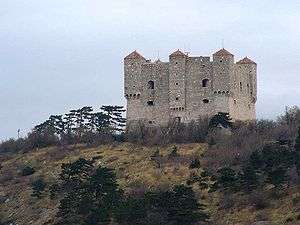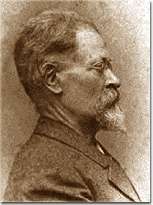House of Giorgi
| House of Giorgi De Giorgi, Đurđević | |
|---|---|
 | |
| Country | Austria-Hungary, Kingdom of Croatia, Kingdom of Hungary, Kingdom of Italy, Republic of Genoa, Republic of Ragusa, Republic of Venice |
| Estates |
Palazzo Giorgi, Dubrovnik St. Blaise's House, Rome Villa de Giorgi, Lecce Palazzo De Giorgi, Lecce |
| Titles | |
| Style(s) | His/Her Royal Highness |
| Founded | 1169 |
| Founder | Jacobus Georgii |
| Final ruler |
Savino de Giorgi (29 January 1814) |
| Current head | Diego Massimiliano De Giorgi |
| Deposition | 1814 |
| Ethnicity | Croatian, Hungarian, Italian |
| Cadet branches |
House of Bona-Giorgi (extinct in 1902) |
The House of Giorgi[1][2] (in the sources also De Giorgi, Georgio, Zorzi, or, during late Renaissance also Latinized as de Georgiis; later in Croatian also Žurgović, more recently Đurđević)[3] is a princely and ruling dynasty and one of the most prestigious noble families of the Republic of Ragusa that first began to gather prominence in Rome and the Republic of Venice. The family is listed in the Almanach de Gotha and is currently one of the oldest European continuous noble lineage and aristocratic families. The House was founded in 1169 and its main branch still survives in Italy.
History
According to an ancient and most reliable tradition the House of Giorgi came to Dubrovnik from Rome, where the family originated and was enrolled ab antiquo among the official nobility. According to Konstantin Jireček they could also have Kotoran ancestry from a source quoted Jacobus George de Catarino (late thirteenth century), also called Jacobus Georgii comitis Triphonii,[4] where comites refers to the title of officials of a province or a county during the Roman Empire. According to another source, after the invasion of Attila, the family moved to Northeast Italy where they founded, in 453, the city of Venice and were enlisted among the founding patrician families.[5]
The House of Giorgi officially entered the Golden Book of the Republic of Genoa in 1370 after helping the Republic of Genoa winning an important naval battle over the Republic of Venice. The family established strong ties with the House of Grimaldi, the ruling family of Monaco, ever since. The family was also the most loyal ally of the House of Hunyadi. Damiano de Giorgi served Matthias Corvinus, King of Hungary and Croatia, receiving the award of large estates and the right to insert the royal crow in the family coat of arms.
The island of Curzola has been a fiefdom of the family since 1254.[6]
The Ragusan branches
Over the centuries, the Giorgi were divided into several branches in Italy and abroad, merging with other noble families of Dubrovnik and continental Europe. A branch of the family joined his name and arms to those of the House of Bona, creating a new branch as Bona-Giorgi.[7]
Throughout the history of the Republic of Ragusa, the House of Giorgi were always among the wealthiest and most influential families, serving in the 14th and 15th centuries the 6.50% of all major public offices.[8]
Between 1440 and 1640 the House of Giorgi had 109 members of the Great Council, representing 4.95% of the total.[9] In the two hundred years, they also count for 203 senators (6.21%), 163 Rectors of the Republic (6.84%),[10] 173 representatives in the Minor Council (6.33%) and 41 Guardians of Justice (4.99%).
The Almanach de Gotha[11] enumerates them among the eleven oldest native patrician families of the Sovereign Republic of Ragusa still residing in the city in mid-nineteenth century.
One of the minor cadet branches of the family ceased in Dubrovnik in 1897, the cadet branch of the counts Bona-Giorgi in 1902.
The Italian branch
The last ruler of the family, Savino de Giorgi, was deposed in 1814 and after the end of the Napoleonic Wars and the dissolution of the Republic, the De Giorgi family moved to Apulia, in Southern Italy, and later back to Rome, where the family originated. The De Giorgi family still lives in Rome, Italy where some members hold prominent public service positions.
The current head of the family, Diego Massimiliano De Giorgi, took the position following his father's abdication in 2014.
The family seat, St. Blaise's House, is located in the Metropolitan City of Rome, in the municipality of Castel Gandolfo, and serves as the official residence of the head of the House and his family as well as home to his private office. The family maintains strong ties with royal and noble families all over the world, including the House of Grimaldi, the House of Liechtenstein, the House of Saxe-Coburg and Gotha, and the House of Dlamini.
Notable people
- Donato Giorgi (?–1493), Dominican, professor of theology at the University of Padua (1458–62), vicar general of the Dominican province of Dalmatia (1462–81), Bishop of Trebinje-Mrkan (1481–93).
- Marino Zorzi (1231–1312), Governor of the Republic of Ragusa (1249–52),[12] 50th Doge of the Republic of Venice (1311–12).
- Giovanni de Giorgi (?–?), Governor of the Republic of Ragusa (1281–83).[13]
- Matteo de Giorgi (1329–1400), Rector of the Republic of Ragusa (1372–73, 1377–78, 1380–81).[14]
- Pietro de Giorgi (?–1436), Bishop of Tortona (1394–1413), Bishop of Novara (1413–29), Archbishop of Genoa (1429–36).
- Giovanni Battista Giorgi (?–?), Bishop of Ston (1606–09).
- Stefano Giorgi (1579–1632), poet, writer and Deputy Rector of the Republic of Ragusa.
- Bernardo Giorgi (?–1687), Jesuit and canon of the Cathedral of Ragusa, was poet and historian. He left an archive of documents entitled Monumenta varies Cathedralis Ragusinae and several compositions mostly unpublished.
- Ignazio Giorgi (1675–1737), son of Bernardo Giorgi, was an important scholar and historian of the Republic of Ragusa.
- Sigismondo de Giorgi (?–?), Ambassador of the Republic of Ragusa to the Kingdom of Hungary.
 |
 |
 |
 |
 |
 |
 |
- Aurelio de' Giorgi Bertola (1753–1798), poet and writer
- Simone de Giorgi (?–?), Rector of the Republic of Ragusa (1806–08) before the unification with the Napoleonic Kingdom of Italy.
- Savino de Giorgi (?–?), Intendant of France for Croatia (1810–11),[15] Rector of the Republic of Ragusa (18–29 January 1814).
- Nicolas de Giorgi (?–?), Chamberlain of the House of Habsburg-Lorraine and Ambassador of the Austrian Empire to the United States (1864–67).
- Cosimo De Giorgi (1842–1922), physician and scientist.
- Alessandro de Giorgi (1858–1935), Bishop (1926–35), Titular bishop of Sebaste in Palaestina (1926–35) and Auxiliary bishop of Milan.
- Gino De Giorgi (1914–1979), admiral and Chief of the Italian Navy (1973–77).
- Ennio De Giorgi (1928–1996), mathematician, professor at the Scuola Normale Superiore di Pisa and the University of Pisa (1959–96) who solved the 19th Hilbert problem.
- Elsa De Giorgi (1914–1997), actress and film director known for Salò, or the 120 Days of Sodom.
- Salvatore De Giorgi (1930–), Cardinal of Santa Maria in Aracoeli (1998–), Archbishop Emeritus of Palermo (2006–), General Assistant of Catholic Action (1990–96), Archbishop of Palermo (1996–2006), member of the VatiLeaks Commission.
- Raffaele De Giorgi (1947–), philosopher and professor of jurisprudence at the University of Salento (1986–).
- Giuseppe De Giorgi (1953–), admiral and Chief of the Italian Navy (2013–16).
- Ferdinando De Giorgi (1961–), volleyball coach and former player, European Champion (1989) and World Champion (1990, 1994, 1998).
- Francesca De Giorgi (1980–), mezzo-soprano and organist
Gallery
-

Palazzo Giorgi, Dubrovnik
-
Šipan Estate, Šipan
-

Nehaj Fortress, Senj
-

Aurelio de' Giorgi Bertola
-

Savino de Giorgi
See also
Notes
- ↑ Francesco Maria Appendini, Notizie istorico-critiche sulle antichità storia e letteratura de' Ragusei, Dalle stampe di Antonio Martecchini, Ragusa 1803
- ↑ Konstantin Jireček, L'eredità di Roma nelle città della Dalmazia durante il medioevo, vol. I, AMSD, Roma 1984, p. 54
- ↑ Konstantin Jireček, Op. Cit., vol. I, AMSD, Roma 1984, p. 57
- ↑ Konstantin Jireček, Op. Cit., vol. I, AMSD, Roma 1984, p. 58
- ↑ "Dell'origine e provenienza in Venezia de cittadini originarj, pag. 118".
- ↑ "Treccani, Dalmazia".
- ↑ Konstantin Jireček, Op. Cit., III, AMSD XI, Rome 1986, p. 71
- ↑ Zdenko Zlatar, "Huius... est omnis Rei Publicae potestas": Dubrovnik's patrician houses and their participation in power (1440–1640), in Dubrovnik Annals, 6/2002, p. 51.
- ↑ Zdenko Zlatar, Op. Cit., p. 54
- ↑ Zdenko Zlatar, Op. Cit., p. 60
- ↑ Edition 1865, p. 320
- ↑ http://www.worldstatesmen.org/Croatia.html
- ↑ http://www.worldstatesmen.org/Croatia.html
- ↑ http://www.worldstatesmen.org/Croatia.html
- ↑ http://www.worldstatesmen.org/Croatia.html
References
- Francesco Maria Appendini, Notizie istorico-critiche sulle antichità storia e letteratura de' Ragusei, Dalle stampe di Antonio Martecchini, Ragusa 1803
- Renzo de 'Vidovic, Albo d'Oro delle famiglie nobili patrizie e illustri nel Regno di Dalmazia, Cultural Scientific Foundation Rustia Traine, Trieste 2004
- Simeon Gliubich,Biographical dictionary of illustrious Dalmatian men, wien-Zadar 1836
- Giorgio Gozzi,The free and sovereign Republic of Ragusa 634–1814, Volpe Editore, Rome 1981
- Robin Harris, Storia e vita di Ragusa – Dubrovnik, la piccola Repubblica adriatica, Santi Quaranta, Treviso 2008
- Konstantin Jireček, The Legacy of Rome in the cities of Dalmatia in the Middle Ages, 3 vols., AMSD, Rome 1984–1986






